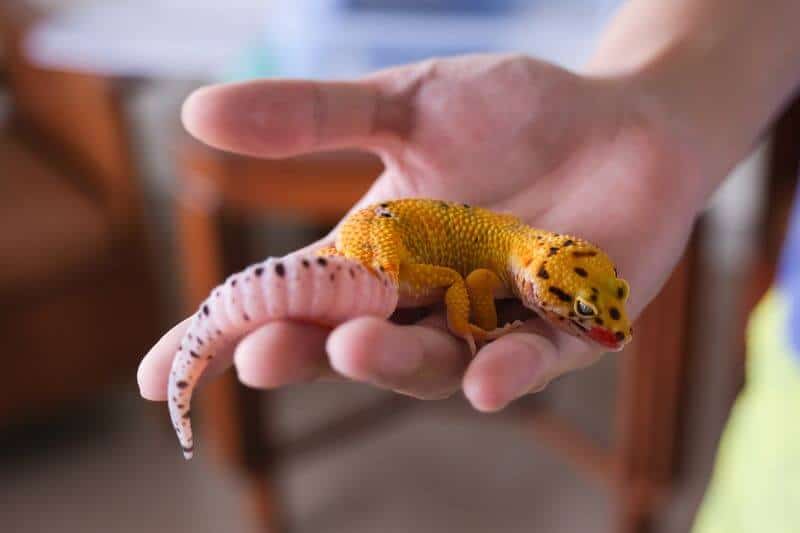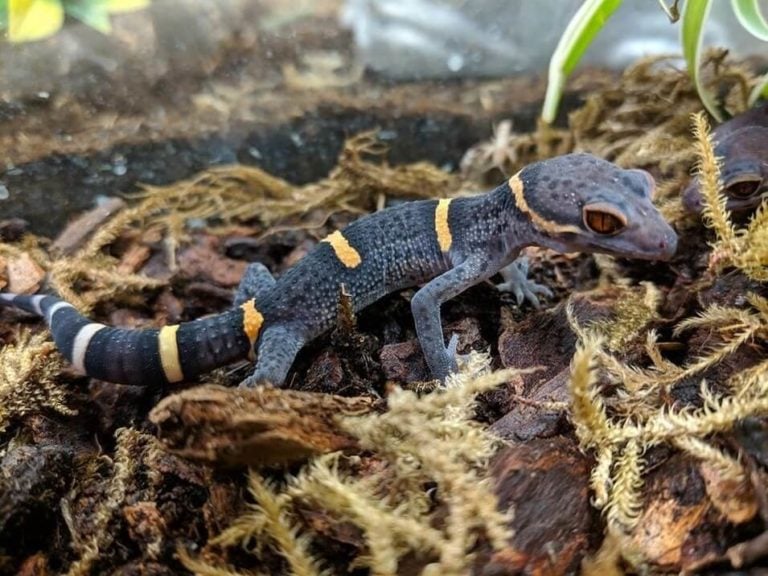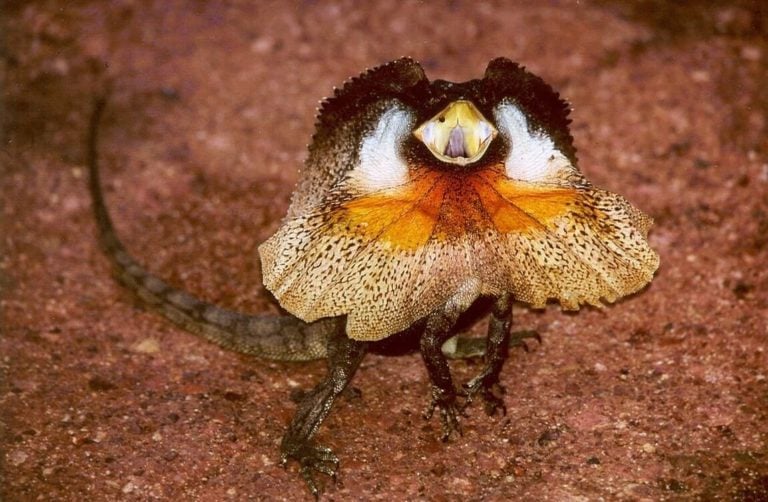Understanding leopard gecko tail rot is important if you want to keep these lizards healthy in captivity. This common condition can easily plague your pet if you’re not careful!
This guide will cover everything you need to know about tail rot in leopard geckos. You’ll learn about causes, treatment, prevention, and more!
Table of Contents
Leopard Gecko Tail Rot: What Is It?
Also known as tail necrosis, tail rot is a health condition affecting many species of pet lizards. It’s prevalent in leopard geckos and can cause severe health complications if left untreated.
As the name implies, leopard gecko tail rot occurs when a part of the tail becomes infected and begins to decay. It’s a type of bacterial infection that can quickly spread. Usually, it starts at the tip of the tail and works its way up, causing worsening health problems as it spreads.
If left untreated, tail rot has the potential to be fatal. It can also cause your leopard gecko to lose their tail entirely, resulting in diminished quality of life and many other issues.
Fortunately, tail rot in leopard geckos is treatable. However, you must address the issue as soon as possible to avoid exacerbating complications.
Signs Of Tail Rot In Leopard Geckos
Tail rot in leopard geckos is an awful condition, and it’s one that pet owners can’t ignore. Fortunately, there are many telltale signs that this ailment is affecting your leopard gecko.
The severity of these symptoms can vary from case to case, but here are some of the most common indicators for this condition.
1. Visual Discoloration & Decay
The most obvious sign that your leopard gecko has tail rot is discoloration.
When the infection takes hold, it usually affects the tip of the tail first. The infection causes the tissue to decay, resulting in a noticeable color change. Typically, the color will darken to a brownish-purple hue.
In some cases, it turns black or gray. When it gets to that point, it often means that the infection is causing severe problems with your leopard gecko’s health. The discoloration and apparent decay may be just the start, and you might end up noticing other signs of illness.
Many leopard geckos suffering from tail rot will experience other visual changes as well. For example, the tissue often dried out. It can become shriveled and lifeless, appearing as if the tail has zero blood circulation.
The area surrounding the rotted section may also take on a leathery texture. Scales rise, and new patches of darkened, thick skin will develop near the infection.
There’s a stark difference between standard skin-shedding and tail rot. When your leopard gecko sheds, it’s only the epidermis that peels off. But with tail rot, the appendage itself is what’s affected.
2. Loss Of Appetite
It’s not just physical symptoms that affect leopard geckos with tail rot. The infection takes its toll on your lizard’s overall health, causing many behavioral changes.
One example is a sudden loss of appetite. Your leopard gecko will get weak as the infection ravages the body. They’ll have no energy to eat and usually refuse food. If your pet normally eats without hesitation, take that as a cause for concern.
Now, many leopard geckos lose their appetite after shedding. However, it typically goes back to normal after three to four days. If they still refuse to eat after four days, check your lizard’s tail for signs of fit rot.
It’s common for leopard geckos to lose weight and get even sicker when dealing with tail rot.
3. Lethargic Behavior
General lethargy is another common behavioral change associated with leopard gecko tail rot.
Again, this is a sign that many owners don’t take seriously right away. Lethargy also occurs when a leopard gecko sheds its skin. But like changes in their appetite, these issues go away after the lizard completes the shed cycle.
When they don’t, it could be an indicator of a more serious health problem. Infections drain your small lizard of energy, making them noticeably less active. They’ll spend less time exploring the enclosure and move slower than these active reptiles usually do.
4. Hiding More Than Normal
If you don’t see your leopard gecko much, it could mean they’re hurt or ill. These creatures are relatively outgoing. Reptile enthusiasts love them because of their friendly temperaments and social personalities.
When a leopard gecko remains out of sight and doesn’t spend much time in the open parts of their enclosure, it could spell trouble.
These lizards will go into hiding whenever they’re sick or injured. They’re more vulnerable during those times, so they seek shelter to heal away from the spotlight.
Expert Tip: Many leopard geckos with tail rot will retreat to a hide box and spend most of their time hiding, making it difficult for you to observe their tail and condition. This is why it’s so important to keep tabs on your pet!
Causes Of Leopard Gecko Tail Rot
There’s no single cause of tail rot in leopard geckos. The infection begins and spreads for many reasons.
But to get you started, here are the most common causes.
A Cut Or Injured Tail
Injuries are far more common than most reptile owners realize. While usually easy-going, leopard geckos can get into fights with other lizards in the enclosed habitat.
They can also cut themselves on sharp decorative items. Leopard geckos will use rough surfaces to peel away the dried epidermis layer during the shed cycle. But sometimes, even something as innocent as a shed cycle can pave the way for the infection to take hold.
There are a couple of issues with tail injuries. The first and most common is bacteria. Simple cuts and scrapes provide an avenue for bacteria to enter the body and cause damage. This makes tail rot much more likely to occur.
Insufficient Nutrients
Nutritional deficiencies can wreak havoc on your leopard gecko’s body. The biggest problem with a lackluster diet is that it weakens the immune system.
Potential disease-causing pathogens surround these lizards. Even in the most pristine tank, there’s a possibility of infection. But the leopard gecko’s immune system is usually strong enough to take care of infections before they graduate to tail rot.
The exception is when they don’t get sufficient nutrients. Failing to provide your leopard gecko with a protein-rich diet chock-full of calcium and vitamins could lead to a weakened immune system that cannot stop tail rot from developing.
Blood Clot
Blood clots are a natural response to injuries. They’re gelatinous clumps of blood that form after a cut or abrasion. They’re supposed to stop bleeding but can lead to tail rot in leopard geckos.
The tail is the furthest extremity from their heart. While vessels carry blood to its tip, blood clots can stop the flow entirely. Clots act as plugs to prevent blood flow after an injury. When that injury occurs on the tail, the clots can significantly restrict the flow, causing decay.
Shedding Problems
Shedding is a normal biological process that leopard geckos do regularly. If they’re healthy, it goes off without a hitch. But small slivers of dried skin can cause problems.
Many reptile enthusiasts know how to address stubborn skin around the fingers and arms. There are many ways to help the shedding process and ensure that extra skin doesn’t cause problems, but many fail to pay attention to the tail!
When a piece of dead skin fails to peel off, it can tighten around the tail and restrict blood flow, leading to tail rot. Think of it as a natural and accidental tourniquet. The pressure of that skin cuts off the flow of blood, depriving the delicate tail of the oxygen and nutrients it needs.
Expert Tip: This issue is referred to as dysecdysis. When dysecdysis occurs, you must take action to promote healthy shedding and avoid blood circulation problems.
An Infection
Infections can cause many problems for your leopard gecko, including tail rot. It’s not just disease-causing pathogens that enter the body through a cut. Parasitic, fungal, and viral infections of any kind can lead to tail rot.
Infections of the bone or spine are particularly problematic. Not only do they cause immense health issues, but the infection can enter the bloodstream and affect any nearby tissue. The same goes for infections in muscles or tissue.
Those infections can graduate to necrosis if left untreated. Simple infections are relatively easy to spot, but more complex cases may not manifest physical symptoms until much later.
Abscess Or Cyst
Cysts and abscesses typically occur due to other infections or trauma. The body develops fluid-filled sacs that can grow quickly. Eventually, they may burst or drain, resulting in dehydration, shock, and the further spread of infection.
Cysts usually appear after some underlying infection. Meanwhile, abscesses contain pus and occur when the tissue gets infected. Both are dangerous and should be treated by a veterinarian.
Misc. Other Skin Problems
Unfortunately, tail rot can affect leopard geckos in many ways. In addition to the many causes already covered, simple skin issues can cause necrosis.
Irritation from dry skin, mites, and insect bites can become necrotizing dermatitis. When that occurs, simple irritation can slowly eat away at the skin, affecting the tail and other parts of the body.
Regular enclosure maintenance can help your leopard gecko avoid dermatitis and other miscellaneous skin conditions. Maintaining proper humidity levels and periodic sanitization of every surface makes a big difference.
Leopard Gecko Tail Rot Treatments
There are many ways to treat tail rot in leopard geckos, and the best approach will typically depend on what caused it in the first place. For example, rot caused by shedding issues is usually treatable with a lukewarm bath and misting to encourage that stubborn skin to slough off.
Whatever the cause, it’s always wise to seek veterinarian care. You may assume that minor discoloration is no cause for concern. But the earlier you catch tail rot, the better! It quickly spreads and can cause severe health problems.
Furthermore, it can cause leopard geckos to lose their tails entirely.
Vets often recommend a course of antibiotics to treat tail rot in leopard geckos. Antibiotics can tackle infections and slow down the spread of necrosis. Usually, treatment with medication lasts for about a month and requires frequent checkups to assess the spread.
In severe cases, veterinarians may recommend surgery. The goal of surgery is to amputate the rotted portion of the tail to reduce its spread. Amputation seems like a drastic measure, but it’s sometimes the only way to minimize the loss and ensure that further health problems don’t arise.
Vets will use anesthesia and intubate your leopard gecko for breathing. Then, they cut off the damaged tail. Usually, the cut is in front of where the discoloration first starts.
The surgeon will then remove any damaged tissue. Even a tiny amount of infected tissue left behind will lead to further spread, so vets work diligently to amputate as much of the damaged tail as they need.
Surgical amputation can take a toll on leopard geckos, but vets usually prescribe a course of pain-management medications and antibiotics to promote healing.
Don’t worry about the potential impact of amputation on your pet. While taxing, leopard geckos have impressive regenerative capabilities. They naturally drop their tails to distract would-be predators as they make an escape in the wild.
Many will drop their tails in captivity due to stress. Fortunately, these animals can regrow their tails. It usually only takes about 30 days. The regrowth cycle may take longer as your Leo recovers from surgery, but they’ll return to their usual selves in no time.
Ways To Prevent Tail Rot Going Forward
Success rates treating leopard gecko tail rot are high, but it’s far better to prevent these infections than continually treat them.
The best thing you can do to avoid tail rot in the future is to maintain comfortable living conditions and provide excellent care. Invest in the right equipment to ensure that temperature, humidity, and UVB light levels are correct at all times. Avoid major stress-causing fluctuations.
During shedding cycles, pay close attention to humidity and provide a lukewarm water dish for soaking to aid the process.
Invest in high-quality foods for optimal nutrition and take steps to keep your leopard gecko as healthy as possible. Assess the enclosure and remove any objects that could cause injury and infection.
It’s also wise to clean the enclosure routinely. Use reptile-safe disinfectants to avoid bacterial infections and protect your lizard’s health!
Good husbandry is the key to avoiding tail rot. Accidents can happen; you never know when an active reptile like the leopard gecko will hurt itself. But you can take steps to reduce your lizard’s risk of illness and make their enclosure as safe and comfortable as possible.
Conclusion
Leopard gecko tail rot can seem scary, but it’s quite preventable (and treatable) if you know what to do. Simply having this knowledge will go a long way in keeping your pet healthy!
Let us know if you have any questions that we didn’t address in this guide. We’re always happy to help.



